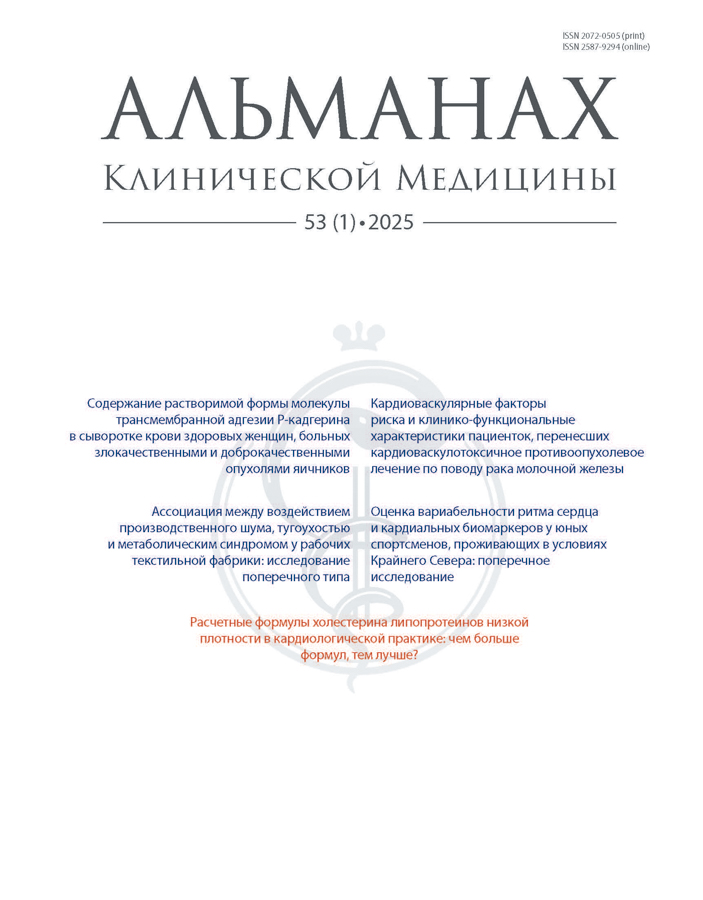Роль гемодинамических ограничений в снижении толерантности к физической нагрузке у пациентов с саркоидозом
- Авторы: Гудим А.Л.1, Постникова Л.Б.2, Болдина М.В.2, Бычкова Е.В.1
-
Учреждения:
- ГБУЗ НО «Городская клиническая больница № 38
- ФГБОУ ВО «Приволжский исследовательский медицинский университет» Минздрава России
- Выпуск: Том 47, № 4 (2019)
- Страницы: 342-349
- Раздел: ОРИГИНАЛЬНЫЕ СТАТЬИ
- URL: https://almclinmed.ru/jour/article/view/1041
- DOI: https://doi.org/10.18786/2072-0505-2019-47-024
- ID: 1041
Цитировать
Полный текст
Аннотация
Цель – комплексное изучение параметров кардиопульмонального нагрузочного тестирования (КПНТ) с газовым анализом у пациентов с саркоидозом органов дыхания (СОД) и оценка влияния гемодинамических ограничений на толерантность к физической нагрузке (ТФН).
Материал и методы. Обследованы 42 пациента с СОД (25 мужчин, 17 женщин) в возрасте 22–62 лет (34,5 (29; 41,5) года). Гистологическую верификацию СОД имели 33 (78,6%) больных. Пациенты со снижением минутного потребления кислорода на пике нагрузки (VO₂ peak pred ≤ 84%), что отражает снижение ТФН, составили 1-ю группу (n = 20), во 2-ю группу вошли 22 пациента с нормальным уровнем VO₂ peak pred (> 84%). У всех пациентов оценивали параметры эхокардиографии и показатели КПНТ, характеризующие ответ сердечно-сосудистой системы на физическую нагрузку: VO₂ на уровне анаэробного порога (VO₂ AT; % от д.в.), кислородный пульс (VО₂/HR; абс/% от д.в.), хронотропно-метаболический индекс (CMI), артериальное давление.
Результаты. В 1-й группе по данным эхокардиографии выявили утолщение задней стенки левого желудочка (р = 0,012), по результатам КПНТ – снижение VO₂ AT (р < 0,001), VО₂/HR (р < 0,001), систолического артериального давления (p = 0,037) на пике нагрузки относительно пациентов 2-й группы. В 12 наблюдениях в 1-й группе VO₂ AT было < 43%, в 6 – VО₂/HR < 80% от д.в., у 3 больных установлен феномен хронотропной некомпетентности.
Заключение. Снижение ТФН по данным КПНТ отмечено у 47,6% пациентов с СОД в отсутствие функциональных нарушений в покое. У 17 из 20 больных 1-й группы снижение ТФН сочеталось с изменениями параметров КПНТ, отражающих гемодинамические ограничения (снижение сердечного выброса, наличие хронотропной некомпетентности).
Об авторах
А. Л. Гудим
ГБУЗ НО «Городская клиническая больница № 38
Автор, ответственный за переписку.
Email: andr6665@mail.ru
ORCID iD: 0000-0002-0341-1708
Гудим Андрей Леонидович - врач-терапевт.
603000, Нижний Новгород, ул. Чернышевского, 22, +7 (987) 557 57 42
РоссияЛ. Б. Постникова
ФГБОУ ВО «Приволжский исследовательский медицинский университет» Минздрава России
Email: plbreath@mail.ru
ORCID iD: 0000-0002-8509-7133
Постникова Лариса Борисовна -доктор медицинских наук, профессор кафедры внутренних болезней.
603005, Нижний Новгород, пл. Минина и Пожарского, 10/1
РоссияМ. В. Болдина
ФГБОУ ВО «Приволжский исследовательский медицинский университет» Минздрава России
Email: mari.boldina@mail.ru
ORCID iD: 0000-0002-1794-0707
Болдина Марина Викторовна - кандидат медицинских наук, ассистент кафедры внутренних болезней.
603005, Нижний Новгород, пл. Минина и Пожарского, 10/1
РоссияЕ. В. Бычкова
ГБУЗ НО «Городская клиническая больница № 38
Email: bev52@rambler.ru
ORCID iD: 0000-0001-9278-740X
Бычкова Екатерина Вячеславовна -врач функциональной диагностики.
603000, Нижний Новгород, ул. Чернышевского, 22
Список литературы
- Визель АА, Визель ИЮ, Амиров НБ. Эпидемиология саркоидоза в Российской Федерации. Вестник современной клинической медицины. 2017;10(5): 66–73. doi: 10.20969/VSKM.2017.10(5).66-73.
- Российское респираторное общество, Общероссийское педиатрическое респираторное общество, Российское научное медицинское общество терапевтов. Саркоидоз. Клинические рекомендации. М.: РРО; 2019. Доступно на: http://spulmo.ru/obrazovatelnye-resursy/federalnyeklinicheskie-rekomendatsii/.
- Rissmiller RW, James WE. Pulmonary function testing and sarcoidosis: A review. Lung Breath J. 2018;2(2): 1–5. doi: 10.15761/LBJ.1000121.
- Баранова ОП, Илькович ММ, Сперанская АА. Трудности диагностики саркоидоза органов дыхания. Практическая медицина. 2011;(3): 58–62.
- Kallianos A, Zarogoulidis P, Ampatzoglou F, Trakada G, Gialafos E, Pitsiou G, Pataka A, Veletza L, Zarogoulidis K, Hohenforst-Schmidt W, Petridis D, Kioumis I, Rapti A. Reduction of exercise capacity in sarcoidosis in relation to disease severity. Patient Prefer Adherence. 2015;9:1179–88. doi: 10.2147/PPA.S86465.
- Baughman RP, Sparkman BK, Lower EE. Six-minute walk test and health status assessment in sarcoidosis. Chest. 2007;132(1): 207–13. doi: 10.1378/chest.06-2822.
- Marcellis RG, Lenssen AF, de Vries GJ, Baughman RP, van der Grinten CP, Verschakelen JA, De Vries J, Drent M. Is there an added value of cardiopulmonary exercise testing in sarcoidosis patients? Lung. 2013;191(1): 43–52. doi: 10.1007/s00408-012-9432-6.
- Kollert F, Geck B, Suchy R, Jörres RA, Arzt M, Heidinger D, Hamer OW, Prasse A, Müller-Quernheim J, Pfeifer M, Budweiser S. The impact of gas exchange measurement during exercise in pulmonary sarcoidosis. Respir Med. 2011;105(1): 122–9. doi: 10.1016/j.rmed.2010.09.007.
- Alshimemeri AA, Itani M, Al-Jahdali H. Respiratory patterns throughout incremental exercise in individuals with sarcoidosis. Innovative Journal of Medical and Health Science. 2013;3(4): 149–52. Available from: http://www.innovativejournal.in/index.php/ijmhs/article/view/500.
- Lopes AJ, Menezes SL, Dias CM, Oliveira JF, Mainenti MR, Guimarães FS. Cardiopulmonary exercise testing variables as predictors of long-term outcome in thoracic sarcoidosis. Braz J Med Biol Res. 2012;45(3): 256–63. doi: 10.1590/S0100-879X2012007500018.
- Wallaert B, Talleu C, Wemeau-Stervinou L, Duhamel A, Robin S, Aguilaniu B. Reduction of maximal oxygen uptake in sarcoidosis: relationship with disease severity. Respiration. 2011;82(6): 501–8. doi: 10.1159/000330050.
- American Thoracic Society; American College of Chest Physicians. ATS/ACCP Statement on cardiopulmonary exercise testing. Am J Respir Crit Care Med. 2003;167(2): 211–77. doi: 10.1164/rccm.167.2.211.
- Ward SA, Palange P, editors. Clinical Exercise Testing. Eur Respir Mon; 2007: 40. 245 р.
- Ярцев СС. Основы функциональной диагностики внешнего дыхания. Эргоспирометрия: практическое руководство для врачей. М.: РУДН; 2015. 236 c.
- Lauer MS, Okin PM, Larson MG, Evans JC, Levy D. Impaired heart rate response to graded exercise. Prognostic implications of chronotropic incompetence in the Framingham Heart Study. Circulation. 1996;93(8): 1520–6. doi: 10.1161/01.CIR.93.8.1520.
- Brubaker PH, Kitzman DW. Chronotropic incompetence: causes, consequences, and management. Circulation. 2011;123(9): 1010–20. doi: 10.1161/CIRCULATIONAHA.110.940577.
- Barros WG, Neder JA, Pereira CA, Nery LE. Clinical, radiographic and functional predictors of pulmonary gas exchange impairment at moderate exercise in patients with sarcoidosis. Respiration. 2004;71(4): 367–73. doi: 10.1159/000079641.
- Попова ЕН, Стрижаков ЛА, Шоломова ВИ, Пономарев АБ, Моисеев СВ, Бровко МЮ, Бондаренко ИБ, Пономарева ЛА, Фомин ВВ. Клинические особенности поражения сердца при генерализованном саркоидозе. Терапевтический архив. 2018;(1): 54–9. doi: 10.17116/terarkh201890154-59.
- Birnie DH, Nery PB, Ha AC, Beanlands RS. Cardiac sarcoidosis. J Am Coll Cardiol. 2016;68(4): 411–21. doi: 10.1016/j.jacc.2016.03.605.
- Hamzeh N, Steckman DA, Sauer WH, Judson MA. Pathophysiology and clinical management of cardiac sarcoidosis. Nat Rev Cardiol. 2015;12(5): 278–88. doi: 10.1038/nrcardio.2015.22.
Дополнительные файлы








